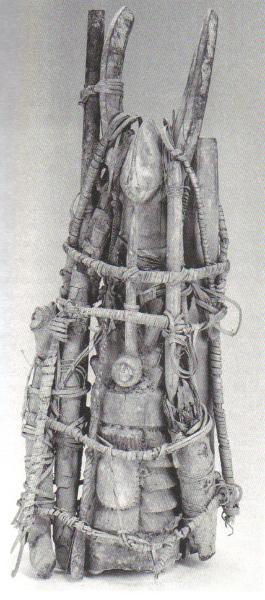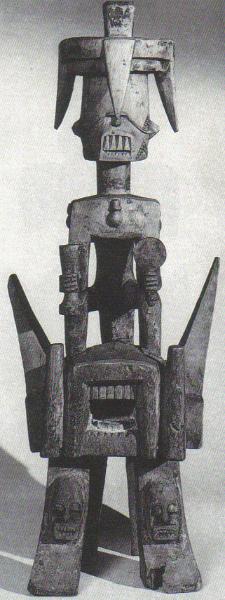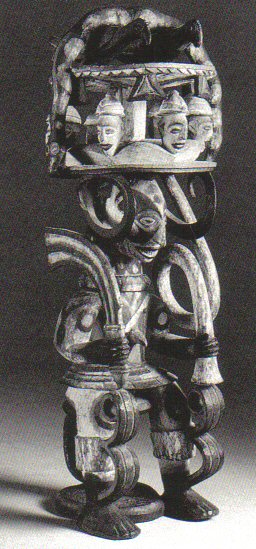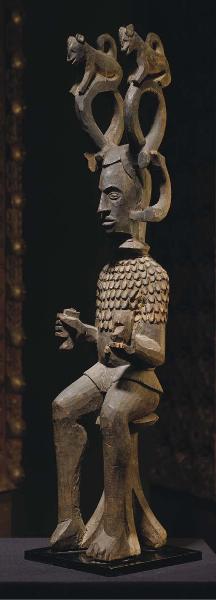
| Ibo / Igbo Ikenga figures and other personal altar figures Amongst the Igbo, . . . sculptures called ikenga are used in male cults that address the powers, successes, and failures of an individual. These images are found in shrines of individual diviners and corporate tutelary cults as representatives of age grades and communities. Personal Altars Men among several ethnic groups commission (or used to commission) personal altars, to be dedicated and consecrated to their personal strength, success, and accomplishments, and sometimes as well to their protection. Warriors, farmers, traders, smiths, and others prayed and sacrificed to these altars before important undertakings, offering further gifts after meeting with success (or sometimes berating the altar after failure). The Igbo, who have the greatest numbers and most variable forms of personal altars, call them ikenga, the Igala know them as okega, and among the Edo of Benin the term is ikengobo. That these names are cognate virtually proves a historical relationship, even if scholars are uncertain which of the three groups originated the idea. Personal altars among these three groups are dedicated to the hand, specifically the right hand (and arm) among the Igbo and the Igala. Strong hands and arms are agents of physical prowess, necessary for success in such activities as hunting, farming, and warfare. The iconography of many altars reflects these associations. Igbo ikenga, for instance, typically show a horned warrior holding a knife in his right hand and a human trophy head in his left, symbols probably established long ago when the Igbo were active head hunters (fig. 9-29). Similar iconography appears in some Igala okega, although the one shown here, like many Igbo examples, depicts only a horned head above a geometrically abstracted, spool-like body (fig. 9-30). Sharp horns are the most essential feature of Igbo and Igala altars to the hand. Some are straight, others are spiral, still others are fancifully curved and elaborated with perching animals. All are commonly referred to as ram horns, even though they often do not resemble them. Yet since virtually all animal horns are power symbols, an identification with a specific animal hardly seems imperative for it is animalistic aggression in general that is evoked. A richly figured, texturally sumptuous, cast copper-alloy iken-gobo from the court of Benin includes depictions of right and left hands in its lower zone, where they alternate with the heads of miniature leopards and cows, the latter sacrificed to help insure success. The figures depicted in relief on the side of the altar, as well as the three that crown its top, depict the king flanked by attendants, a typical motif from this culture's courtly tradition, which repeatedly emphasizes the centrality of its ruler. Lesser Benin chiefs and ordinary men also used to commission ikengobo. These were generally carved of wood, although several cast metal examples are known. Most are crowned with a spike on which an elephant tusk was almost certainly displayed, echoing again the theme of the animal horn familiar from Igbo and Igala examples. Among the Isoko and the Urhobo, Edo-speaking peoples living south of Benin, personal shrines prominently display the horns and teeth of imaginatively conceived (and unidentifiable) quadrupeds. These altars, both called ivri, explicitly merge human and animal imagery. In Urhobo altars, the animal is often dominant (fig. 9-31). Here the animal prevails because of its size, whereas the comparatively larger human dominates the animal in the stunning Isoko example shown in figure 9-32, a masterful composition whose sculptural power is appropriate to its (former) job as a protective, aggressive combatant for its owner. The teeth and horns on these images—sharp, bared, and exaggerated—signal their pugilistic purposes. Both carvings are symmetrical on the vertical axis. The Urhobo ivri is weighted and more stable on its animal base, whereas the Isoko figure, built up as a rhythmic series of bulges and constrictions from bottom to top, points upward and almost seems to soar. Source for information and images: "A History of Art in Africa" Click on any image to see larger version |
| Figure 9-32 |
| Figure 9-31 |
| Figure 9-29 |
| Figure 9-30 |
| 9-29. IKENGA (PERSONAL ALTAR). IGBO. 2OTH CENTURY. WOOD. HEIGHT 19.5" (49.53 CM). THE METROPOLITAN MUSEUM OF ART, NEW YORK. GIFT OF JOHN H. R. BLUM |
| 9-30. OKEGA (PERSONAL ALTAR). IGALA. EARLY 20th CENTURY. WOOD, FIBER, PIGMENTS, KAOLIN, STRING, IRON HEIGHT 24.5" (62.2 CM). NATIONAL MUSEUM OF AFRICAN ART, SMITHSONIAN INSTITUTION, WASHINGTON, D.C. GIFT OF ORREL BELLE HOLCOMBE IN MEMORY OF BRYCE HOLCOMBE This particular okega retains the heads of some animals that were sacrificed to it. The heads were probably lashed on to advertise and increase the altar's powers |
| 9-32. IVRI (PERSONAL SHRINE). ISOKO. 19TH-2OTH CENTURY. WOOD HEIGHT 28" (71.1 CM). THE WALT DISNEY-TISHMAN AFRICAN ART COLLECTION |
| 9-31. IVRI (PERSONAL SHRINE). URHOBO. 20TH CENTURY. WOOD. THE BRITISH MUSEUM, LONDON |
| I do not have any Ibo or Igbo figures in my collection Below are examples for reference purposes |
| An Igbo Ikenga figure wood and pigments height 76.2 cm / 30" From the book: The Tribal Arts of Africa |
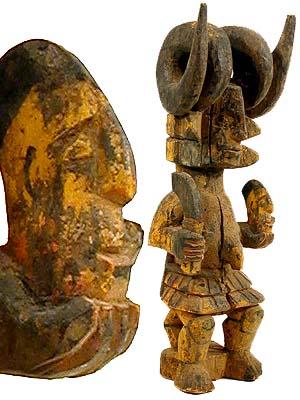
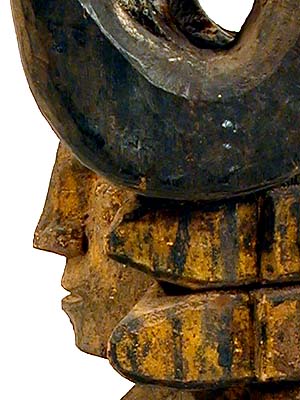

| An ikenga figure from the Hamill Gallery in Boston. This is the form that I enjoy the most with the curled horns on the head and the knife in one hand and the head in the other. |
| Christie's - Paris Collection Patrice Trigano Itinéraire d'une passion Auction Date : Jul 5, 2005 Lot 128 : STATUETTE IBO IKENGA Description Nigéria Représentant un personnage assis sur un tabouret à quatre pieds, portant un pagne de plumes et tenant une épée dans sa main droite et une tête dans sa main gauche, le visage aux traits stylisés placé sous une coiffe composée de serpents formant des boucles et de deux petits lions au sommet. Patine sombre, manques. Hauteur: 91 cm. Estimate:€ 2,000 - € 3,000 Price Realized: € 2,160 $ 2,602 Provenance André Scholler, Paris |
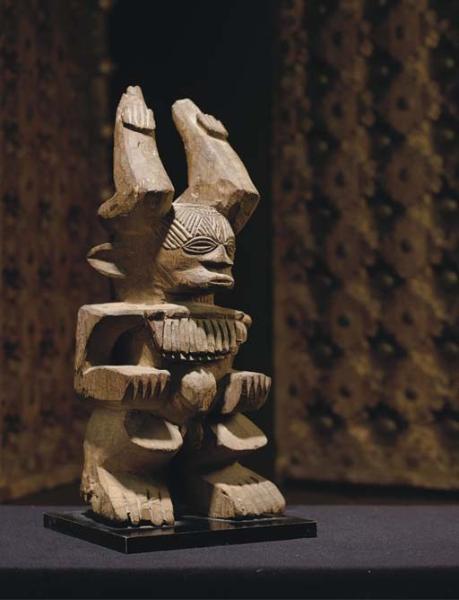
| Christie's - Paris Collection Patrice Trigano Itinéraire d'une passion Auction Date : Jul 5, 2005 Lot 127 : STATUETTE IBO IKENGA Description Nigéria Représentant un personnage masculin au corps massif, le visage au nez épaté, aux yeux en amande, le front recouvert de scarifications formant des motifs triangulaires, le tout placé sous deux cornes avec sur chacune une main en relief. Hauteur: 44 cm. Estimate:€ 1,000 - € 1,500 Price Realized:€ 1,200 $ 1,446 |

| Christie's - Paris Art Africain et Océanien Auction Date : Jun 7, 2005 Lot 216 : STATUETTE IBO IKENGA Description Nigéria La base circulaire facettée supportant un corps cylindrique à la tête décorée de motifs hachurés supportant deux cornes recourbées. Patine croûteuse et restes de pigments. Hauteur: 83 cm. Estimate:€ 400 - € 600 Price Realized:€ 1,440 / $ 1,735 This figure is also below in a Christie's auction from 2002 |
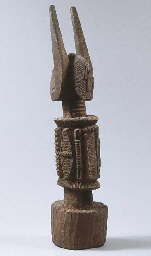
| Christie's - Amsterdam TRIBAL ART Auction Date : Sep 12, 2002 Lot 269 : A LARGE IBO IKENGA FIGURE Description With carved panels in high relief about the cylindrical body, the slender head with cross-hatched ornament to the sides, curved horns, on faceted cylindrical base, encrusted patina with traces of pigments 83cm. high. Estimate:$ 776 - $ 1,164 Price Realized:$ 0 |
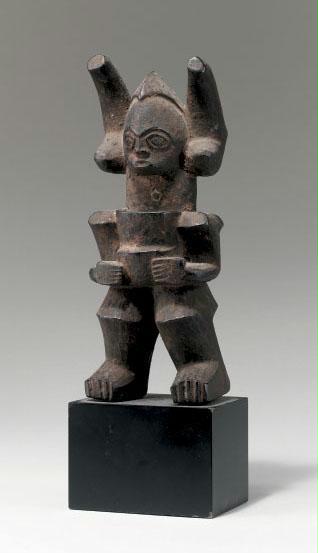
| Sotheby's - New York Arts of Africa, Oceania & The Americas Auction Date : May 17, 2002 Lot 120 : A FINE IBO IKENGA FIGURE Description of overall cubistic form and standing on muscular legs, the broad torso with shelf-like shoulders, the bent arms holding a container to the front, the thick neck supporting a head with diminutive features and large arching horns; encrusted greyish brown patina. Estimate:$ 6,000 - $ 9,000 Price Realized:$ 7,170 Provenance Saja Tunkara, 1964 Irwin Hersey, New York Cecilia and Irwin Smiley Collection |
| For information and visual reference the G.I. Jones photographic archives is a great source for photographs of the various Igbo and Ibo peoples: http://mccoy.lib.siu.edu/jmccall/jones/ |
| Rand African Art home page Educational Resources page |

